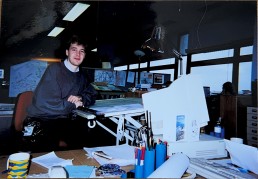By Martin Hird
For a little while now I’ve been conscious that changes are afoot in the world of Landscape Architecture. Early last year I resolved to keep up with the curve, so I took the plunge and booked myself on to the Landscape Institute conference ‘Digital Practice and Technology for Landscape’.
I didn’t know what to expect. I wondered if it might be some kind of showcase for all the latest technological innovations. I thought I might be wowed by Virtual Reality headsets and the like. It turns out, the seminars were more balanced and perhaps a little wary of technology than I had anticipated. It was fascinating (and mildly amusing) to look around the conference venue and see that the delegates broadly fitted into two types. Those who were young, energised and enthralled by the possibilities that emerging technologies present, and those who were a little older and had a slightly shell-shocked expression on their faces. You can work out which type I fall into.
I wasn’t expecting to come away from the day feeling melancholy, but I did, with a realisation that the nature of Landscape Architectural practice is about to change quite radically. And here’s why (I don’t have the facts behind these figures, but if you want to delve a little deeper, may I suggest you check the recordings of the seminars on LI Campus).
Over the next 5 years, the use of Artificial Intelligence (A.I.) is set to increase by about 300%. There are 3 types of A.I.:-
- ‘Narrow’ intelligence (eg. spellcheck / predictive text). This stuff has been around for quite a while now. We’re pretty used to it.
- ‘Generative’ intelligence (eg. chat / generation of visualisations etc). This technology is rapidly emerging. Lots of people have been dipping their toe in, but to many of us it’s a bit unfamiliar.
- ‘General’ intelligence (i.e. anything a human does). We’re into Science Fiction here. Except that its no longer fiction. Technology exists (albeit primitive) and is being developed which will create machines that think like humans. The replicants of Blade Runner spring to mind.
But what are the implications for Landscape Architecture? For a start, deadlines will get shorter (and more pressurised) because client’s expectations will be skewed by their understanding of what’s achievable in the context of A.I.

Paradoxically for me, this realisation brought to mind The Honeywood File, a wonderful book first serialised in the Architects Journal in the 1920’s. It humorously paints a picture of a slightly hapless Architect and his often turbulent stewardship of a building project from inception to completion. Whilst it reveals that some of the pitfalls and the need for clear communication are as relevant today as they were in the 1920’s, the mechanisms for undertaking a building project have evolved considerably. The Honeywood File paints a picture of a world where design drawings are produced by hand, and communication with client, contractor etc. are done by letter. Project work proceed at a pace dictated by the postal system.
Since the advent of AutoCAD and email things have sped things up considerably. Accordingly clients expectations will have changed, although this will have been incremental. That shift is set to continue, perhaps more perceptibly so, as Landscape practitioners should consider their fee charging structures to reflect clients expectations that work can be produced by technology at ultra-speed (and of course they won’t want to pay for a human to do it at tedious old human speed). In order to remain as viable businesses, we’ll need to factor-in more time for checking the work done by A.I., and charge for that.
Our Professional Code of Conduct still applies. Tempted though we may be by the abilities of A.I. to do things we can’t, we should not oversell our capabilities. In the context of the Building Safety Act 2022, and the requirement for all involved in a build project to demonstrate their competency, it’s very important to remember that we need to have the skills to check the accuracy of anything we ask A.I. to do on our behalf.
A.I. could also create a skills gap. The project support currently provided by graduates and apprentices could easily (and more cheaply) be replaced by A.I. But it strikes me that there may be less of a reason to teach certain skills ‘manually’ at university. I recall (with some satisfaction I must admit) being taught how to work out complex gradients, ramps, retaining walls, cut-and-fill etc., scribbling lots of calculations on scrap bits of paper. But what’s the point of learning to do levels that way any more, when A.I. can work it all out for you in seconds? Then again, without knowing what to do with an old-fashioned calculator, how would humans have the necessary skills to check the work generated by A.I.?

Around the time this photo was taken I also recall undertaking LVIA fieldwork using a camera with actual film in it. We were constrained to taking only 36 photos, so we had to be pretty confident we’d got the right shots. These days, with digital cameras, we can take as many shots as we like, and we can download them and use them immediately upon our return to the office. So clearly in this instance digital technology has been very successful in eliminating risk and providing efficiency.
As things stand, ‘generative’ intelligence isn’t good at plant selection. It doesn’t tend to come up with a species choice suitable for the UK (although it could perhaps be trusted to generate a concept design). So, the onus is still on us to know our plants. If a landscape contractor tried to plant an A.I. generated design, the chances are they’d be complaining that the specified plants weren’t available, or wouldn’t survive in our climate, or might just be bizarre in the context of what exists in the surroundings.
We will also need to consider morality. If we use A.I. might we be copying somebody else’s work? The Data source for ‘generative’ intelligence is anything that’s put into it. There’s no means of policing this, and as such there are legal concerns regarding privacy / copyright.
The morality of new technologies also extends to our attitude towards the climate emergency. Digital practice is actually very bad for the environment. Data Centres are very energy hungry. They use immense amounts of water to cool down servers (just a few days ago the BBC reported that the UK’s A.I. ambitions could lead to water shortages), and C02 emissions from Data Centres are already greater than that from the Aviation industry.
And here’s a thought… Online meetings are arguably more harmful to the environment than in-person meetings. Whilst in-person meeting require travel an on-line meeting might have say 12 people all sitting in rooms that are separately lit, heated, and with powered-up computers. This may be more energy hungry that 12 lots of travel, particularly taking into account the increase of EV’s and the improving efficiency of battery technology.
I’m not anti-technology, honestly. Some of our forebearers were probably wary of AutoCAD and email, worrying that they wouldn’t be able to keep up with the pace that their clients would expect work to be turned around. But AutoCAD and Email has turned out to be the accepted norm, and the efficiencies they provide no-doubt outweigh any risk of slipping up in a rush. So there’s no reason why, if handled in the right way (whatever that is), the coming of A.I. could not herald a positive paradigm shift for Landscape Architecture.
For instance, A.I. can process data much, much quicker than a human can undertake the same task. It can be used internally, i.e. as a tool to grab / process your own secure data, perhaps fulfilling administrative functions such as bookkeeping and invoicing. Releasing humans from these systematic / operational tasks might allow their time to be diverted to more creative thinking.


So, in summary… is digital practice a good thing?
On the surface our profession may appear very different in the years to come. However, much like the Honeywood File, the core principles will surely still be the same. All the right notes, but not necessarily in the right order!
We can’t resist these technological advances, not should we, otherwise our profession would get left behind and we would soon make ourselves obsolete. We need to harness these technological advances, but do so in a very considered way. We can’t procrastinate. These technologies won’t wait for us. Now is the time to give due consideration to these things.

